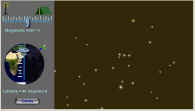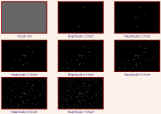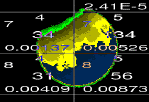 Sky Glow & Total Lunar Eclipse
Sky Glow & Total Lunar Eclipse
Several participants from the Astronomy From the Ground Up online workshop, presented in January, 2008, by the Astronomical Society of the Pacific, intend to track the decrease in sky glow during the February 20, 2008, total lunar eclipse using a Sky Quality Meter (SQM).

 This is an opportunity to practice using the SQMs in public in preparation for
the Globe at Night program coming up
February 25-March 8. Globe at Night is an excellent venue for citizen-scientists
to get out, look up, and contribute observations to a worldwide assessment of
our night sky.
This is an opportunity to practice using the SQMs in public in preparation for
the Globe at Night program coming up
February 25-March 8. Globe at Night is an excellent venue for citizen-scientists
to get out, look up, and contribute observations to a worldwide assessment of
our night sky.
Before the eclipse, you can download a table (below) for visitors to record SQM values and sky conditions onsite during the total lunar eclipse. Listed are the key times for the penumbral and umbral shadow contacts; a diagram of the eclipse highlights; and columns with Time, SQM, Sky, Notes, and By. Print the table for your time zone, then make a zoomed copy onto poster board at a local copy center.
 Eastern Standard Time (EST) |
 Central Standard Time (CST) |
 Mountain Standard Time (MST) |
 Pacific Standard Time (PST) |
Later you can transfer that data to the Google spreadsheet at http://spreadsheets.google.com/ccc?key=p4s-VBT9q2zXDKrOWuTh8Jg&hl=en. Contact Chuck Bueter to request access to the Google document as a collaborator if you wish to participate.
 While some new users of the
SQM may opt to practice taking casual readings, Jan Hollan notes that
there are some procedures to consider before you can infer any knowledge from
the measurements. Concurrently, a lunar eclipse offers an opportunity to
calibrate your instrument. His thoughtful and detailed comments and
several pertinent links are at http://amper.ped.muni.cz/jenik/letters/radiometry/msg00031.html.
While some new users of the
SQM may opt to practice taking casual readings, Jan Hollan notes that
there are some procedures to consider before you can infer any knowledge from
the measurements. Concurrently, a lunar eclipse offers an opportunity to
calibrate your instrument. His thoughtful and detailed comments and
several pertinent links are at http://amper.ped.muni.cz/jenik/letters/radiometry/msg00031.html.